
March 23, 2012
The Covers of J.G. Ballard’s Crash: An Update

Illustration: Igor Kordej. Publisher: Maladost, Zagreb, Croatia, 1988
I bought this Croatian edition of J.G. Ballard’s novel Crash last week in Zagreb. I mentioned my interest in collecting copies of Crash to a designer and writer friend, Dejan Kršić, and within half an hour of prowling he had located this out-of-print edition from 1988 in an antiquarian bookshop. Before we found it, he joked that it would probably turn out to be the worst ever cover of the book. I wouldn’t call it that — there’s some keen competition for the award — but it may well be the weirdest. The cover illustration is by a well-known Croatian comic book artist, Igor Kordej (or Kordey), who later did artwork for Marvel’s New X-Men comics. It hardly needs saying that there are no hunky green robots ravishing women in Crash. Even stranger, the back cover reveals the male to have human legs, while the woman’s legs, also green, are those of a robot. Still, the point about the fusion of desire and technology is made, even if the imagery has no relation whatsoever with Ballard.
In 2004, I wrote an essay for Eye magazine (not online) about cover treatments of Ballard’s most disturbing novel, and a shorter version with pictures was later published on the Ballardian website. As I explained in the piece, my collection started quite casually, although I was an admirer of Ballard and the book, and over the years I just kept on going with it. When I was abroad, if I happened to remember, I would look for the novel in bookshops, and before the Internet this was the only way to obtain foreign editions in places where I didn’t have contacts to ask for help. It might sound obsessive, but I’m not a completist out to own every edition ever printed, and I still prefer to find new copies by chance on my travels. It was intriguing, as my small collection grew, to see how few publishers and designers had any idea how to interpret the cult novel’s obscene and seemingly unrepresentable theme: the sexual possibilities of the car crash. Ballard himself described the book as pornographic, though I think extreme is a more fitting word. Of the 16 covers shown in Eye, only three or four were any good. Many were hopeless not only as interpretations but even in the rudimentary details of their typography and design.

Design: Dragan Bibin. Publisher: ÄŒarobna knjiga, Belgrade, Serbia, 2011
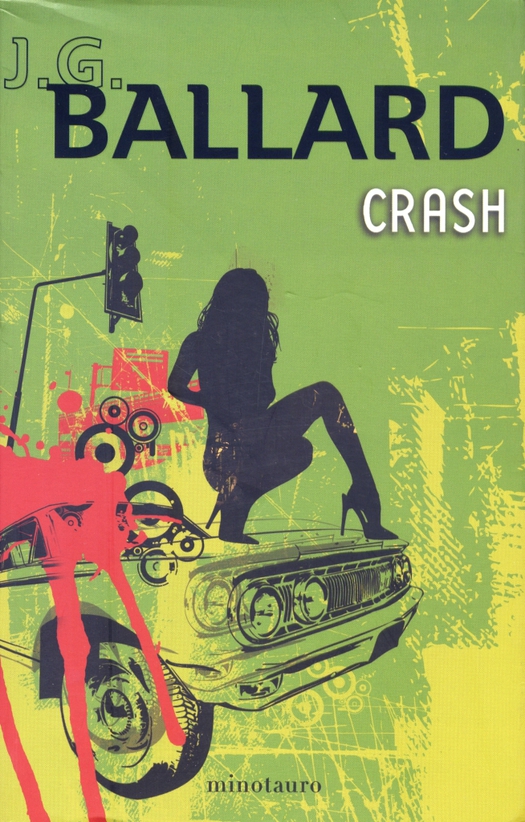
Illustration: Leo Flores. Publisher: Ediciones Minotauro, Barcelona, Spain, 2008
Since the Eye article, quite a few new covers have appeared — three in Britain alone — and I have thought about posting an update. Finding the Croatian edition, as well as a new Serbian edition in Belgrade (above), provides a good pretext. None of the covers here is the brilliantly judged and unimprovable solution that we continue to hope for, but the standard of illustration and design, if not interpretation, in the covers produced in the last decade is certainly an improvement on earlier feeble efforts from the 1970s, 1980s and 1990s. Those covers often said far more about the aesthetic level of book cover design in the countries that produced them than they managed to say about Ballard or his book.

Design: Petr PalarÄík. Publisher: Votobia, Olomouc, Czech Republic, 1995
Kordej’s bizarre cybernetic fantasy aside, there’s no getting away from cars with this novel, even if the reference comes in the attenuated form of tire tracks neatly printed across the model’s compliant flesh.
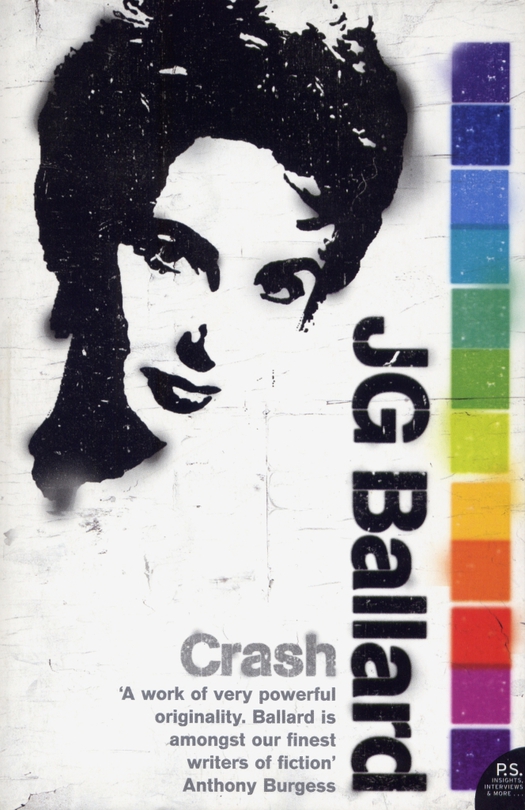
Illustration: David Wardle. Publisher: Harper Perennial, London, UK, 2008
Ballard’s British publisher, Harper Perennial, perhaps recognizing the danger of automotive overkill, has tried to do something different with the trendily Banksy-fied graffito of Elizabeth Taylor (a fetishistic presence in Crash) that decorates the latest, rather tame British cover, which is part of a similarly formatted series. The anachronistic styling doesn’t feel remotely like the book and I hope they change it again soon.
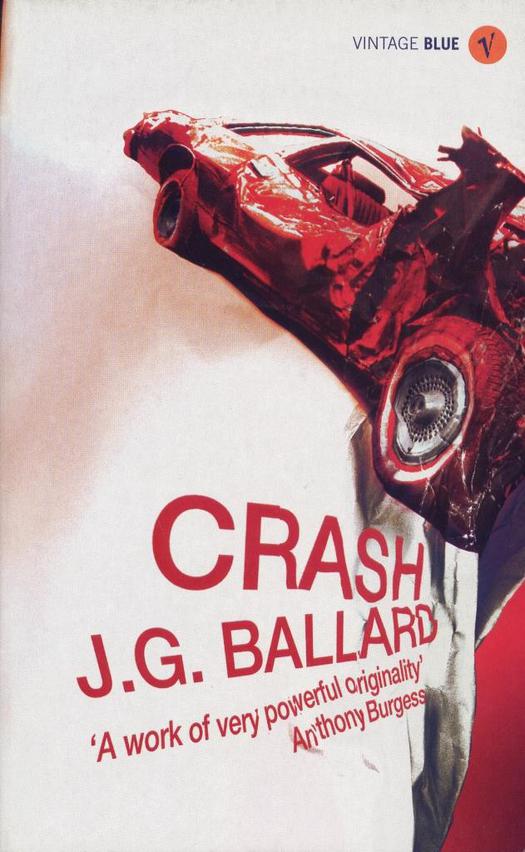
Photograph: Scott Wishart/Millennium. Publisher: Vintage, London, UK, 2004
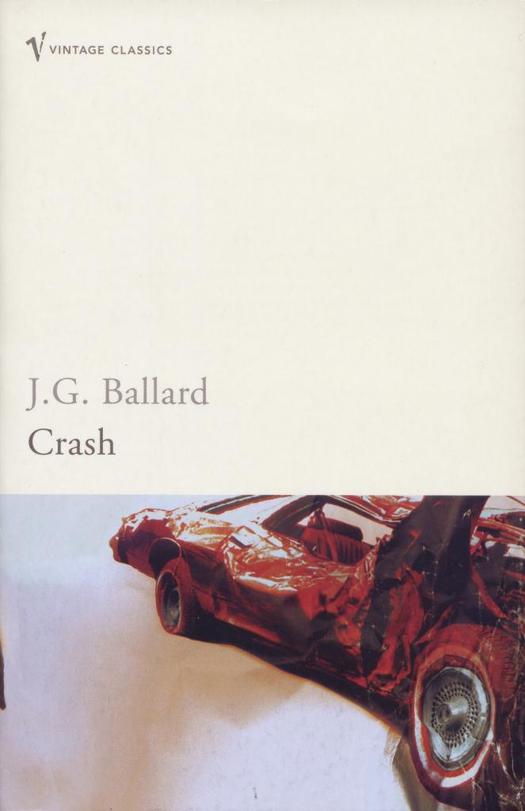
Photograph: Scott Wishart/Millennium. Publisher: Vintage, London, UK, undated, mid-2000s
The earlier British Vintage Blue edition (above) at least had the virtue of looking like a tough and edgy cult book, and the hard-to-decipher, crumpled picture space, as though the cover has also crashed, is an efficient metaphor for the characters’ warped perspectives. The emptiness suggests an art gallery display and this immediately recalls Ballard’s notorious 1970 exhibition of crashed cars. In the selection shown here, that’s the cover that, for me, feels most like the experience of reading Crash, even if it does pussyfoot around the problem of sex. Some of this cold power persists even in the quieter, standardized treatment of the same photograph for Vintage’s series of literary classics.
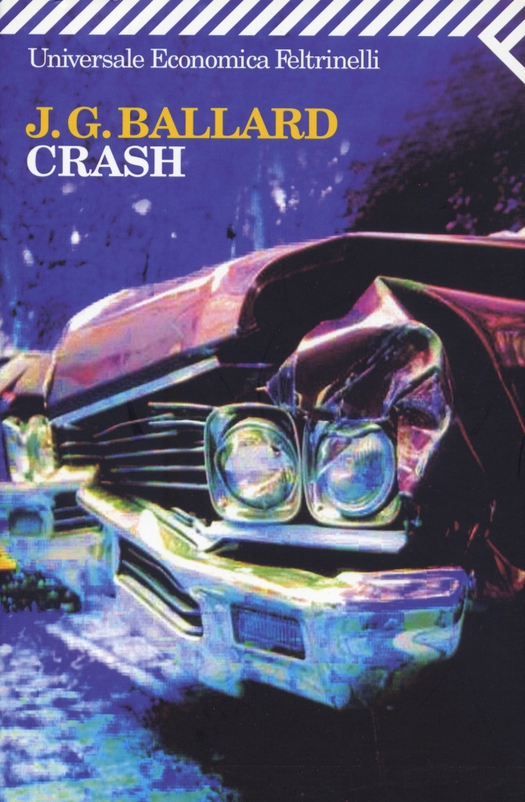
Design: Feltrinelli design studio. Publisher: Feltrinelli, Milan, Italy, 2008
It’s worth also mentioning that in 2007 the challenge of devising a cover for Crash inspired Ballard’s publisher and the Times newspaper to announce a design competition, with the winning entry to be used on a limited edition to be published in September 2008. But Ballard was seriously ill by then (he died in April 2009) and was apparently unable to act as judge, as planned. Although the organizers claimed to have received many entries, no results were ever announced. (Examples of the designs can be found here, here and here, and this is a later speculative design.) It’s a shame because the results could have been as revealing as the cover competitions organized by LA architect John Bertram, who set designers the test of interpreting Vladimir Nabokov’s Lolita and Tadeusz Borowski’s This Way for the Gas, Ladies and Gentlemen. I wrote about the Borowski project on this blog, and a book about the Lolita covers is under way. Is it too much to hope that Bertram might some day consider a new Crash competition to make it a trilogy of ultimate cover design challenges?

Photograph: Jeff Cowen, South Bronx, 1990. Publisher: Denoël & D’Ailleurs, Paris, France, 2005

Photograph: Gerard Fritz/Corbis. Publisher: Denoël, Paris, France, 2007
With thanks to Dejan Kršić (Croatia), Marta Sylvestrová (Czech Republic) and Borut Vild (Serbia).
See also:
What Does J.G. Ballard Look Like?
What Does J.G. Ballard Look Like? Part 2
J.G. Ballard’s Terminal Documents
Observed
View all
Observed
By Rick Poynor
Related Posts

Business
Courtney L. McCluney, PhD|Essays
Rest as reparations: reimagining how we invest in Black women entrepreneurs

Design Impact
Seher Anand|Essays
Food branding without borders: chai, culture, and the politics of packaging

Graphic Design
Sarah Gephart|Essays
A new alphabet for a shared lived experience

Arts + Culture
Nila Rezaei|Essays
“Dear mother, I made us a seat”: a Mother’s Day tribute to the women of Iran
Recent Posts
Courtney L. McCluney, PhD|Essays
Rest as reparations: reimagining how we invest in Black women entrepreneurs Food branding without borders: chai, culture, and the politics of packaging Why scaling back on equity is more than risky — it’s economically irresponsible Beauty queenpin: ‘Deli Boys’ makeup head Nesrin Ismail on cosmetics as masks and mirrorsRelated Posts

Business
Courtney L. McCluney, PhD|Essays
Rest as reparations: reimagining how we invest in Black women entrepreneurs

Design Impact
Seher Anand|Essays
Food branding without borders: chai, culture, and the politics of packaging

Graphic Design
Sarah Gephart|Essays
A new alphabet for a shared lived experience

Arts + Culture
Nila Rezaei|Essays

 Rick Poynor is a writer, critic, lecturer and curator, specialising in design, media, photography and visual culture. He founded Eye, co-founded Design Observer, and contributes columns to Eye and Print. His latest book is Uncanny: Surrealism and Graphic Design.
Rick Poynor is a writer, critic, lecturer and curator, specialising in design, media, photography and visual culture. He founded Eye, co-founded Design Observer, and contributes columns to Eye and Print. His latest book is Uncanny: Surrealism and Graphic Design.